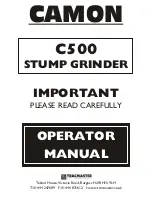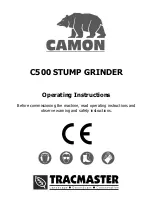
10
ENGLISH
(Original instructions)
Fitting and removing hubbed wheels and cups
Hubbed wheels and cups install directly on the M14 threaded
spindle (11).
Caution! To reduce the risk of personal injury, wear work
gloves when handling wire brushes and wheels.
They can
become sharp.
Caution! To reduce the risk of damage to the tool, wheel
or brush must not touch guard when mounted or while
in use.
Undetectable damage could occur to the accessory,
causing wires to fragment from accessory wheel or cup.
Fitting
u
Thread the hubbed wheel or cup on to the spindle (11) by
hand.
u
Keep the spindle lock (4) depressed and tighten the hub of
the wheel or cup with a wrench.
Removing
u
Keep the spindle lock (4) depressed and loosen the hub of
the wheel or cup with a wrench.
u
Remove the wheel or cup from the spindle (11).
Fitting and removing the battery (fig. G)
u
To fit the battery (7), line it up with the receptacle on the
tool. Slide the battery into the receptacle and push until
the battery snaps into place.
u
To remove the battery, push the release buttons (23) while
at the same time pulling the battery out of the receptacle.
Use
Warning!
Let the tool work at its own pace. Do not overload.
u
Be prepared for a stream of sparks when the grinding or
cutting disc touches the workpiece.
u
Always position the tool in such a way that the guard
provides optimum protection from the grinding or cutting
disc.
Charging the battery (fig. A)
The battery needs to be charged before first use and whenev-
er it fails to produce sufficient power on jobs that were easily
done before. The battery may become warm while charging;
this is normal and does not indicate a problem.
Warning!
Do not charge the battery at ambient temperatures
below 10 °C or above 40 °C. Recommended charging tem-
perature: approx. 24 °C.
Note: The charger will not charge a battery if the cell
temperature is below approximately 10 °C or above 40 °C.
The battery should be left in the charger and the charger
will begin to charge automatically when the cell tempera-
ture warms up or cools down.
u
To charge the battery (7), insert it into the charger (9).
The battery will only fit into the charger in one way. Do
not force. Be sure that the battery is fully seated in the
charger.
u
Plug in the charger and switch on at the mains.
The charging indicator (10) will blink.
The charge is complete when the charging indicator (10)
switches to continuously on. The charger and the battery can
be left connected indefinitely. The LED will switch on as the
charger occasionally tops up the battery charge.
u
Charge discharged batteries within 1 week. Battery life will
be greatly diminished if stored in a discharged state.
Leaving the battery in the charger
The charger and battery pack can be left connected with the
LED glowing indefinitely. The charger will keep the battery
pack fresh and fully charged.
Charger diagnostics
If the charger detects a weak or damaged battery, the charg-
ing indicator (10) will flash red at a fast rate. Proceed as
follows:
u
Re-insert the battery (7).
u
If the charging indicators continues flashing red at a fast
rate, use a different battery to determine if the charging
process works properly.
u
If the replaced battery charges correctly, the original
battery is defective and should be returned to a service
centre for recycling.
u
If the new battery gives the same indication as the original
battery, take the charger to be tested at an authorised
services centre.
Note: It may take as long as 30 minutes to determine that
the battery is defective. If the battery is too hot or too
cold, the LED will alternately blink red, fast and slow, one
flash at each speed and repeat.
Switching on and off
u
To switch on, slide the lock off switch (1) forward then
press and hold the trigger switch (2).
u
To switch off, release the trigger switch (2).
Warning!
Do not switch the tool on or off while under load.
Warning!
Always slide the lock off switch (1) backwards to the
locked position when the tool is not in use.
Hints for optimum use
u
Firmly hold the tool with one hand around the side handle
and the other hand around the main handle.
Surface grinding with grinding wheels
u
Allow the tool to reach full speed before touching the tool
to the work surface.
Summary of Contents for FATMAX FMC761
Page 1: ...www stanley eu FMC761...
Page 2: ...2 C A D B...
Page 3: ...3 E F G H...
Page 156: ...156 Stanley Fat Max 1 2 RCD RCD 3 OFF...
Page 157: ...157 4 5 6...
Page 158: ...158 u u u u u u u u u u u...
Page 159: ...159 u u u u u u u u u u u u u...
Page 160: ...160 u u u u u u u u u u u u u...
Page 161: ...161 u u u u u u u MDF EN 60745 2002 44 E O N u u...
Page 166: ...166 u 5 15 25 mm u u u u u 5 10 u u u u u u u u u u 4 mils u u...
Page 170: ...170 27 27 27 27 27...
Page 171: ...171 1 1 1 27...











































